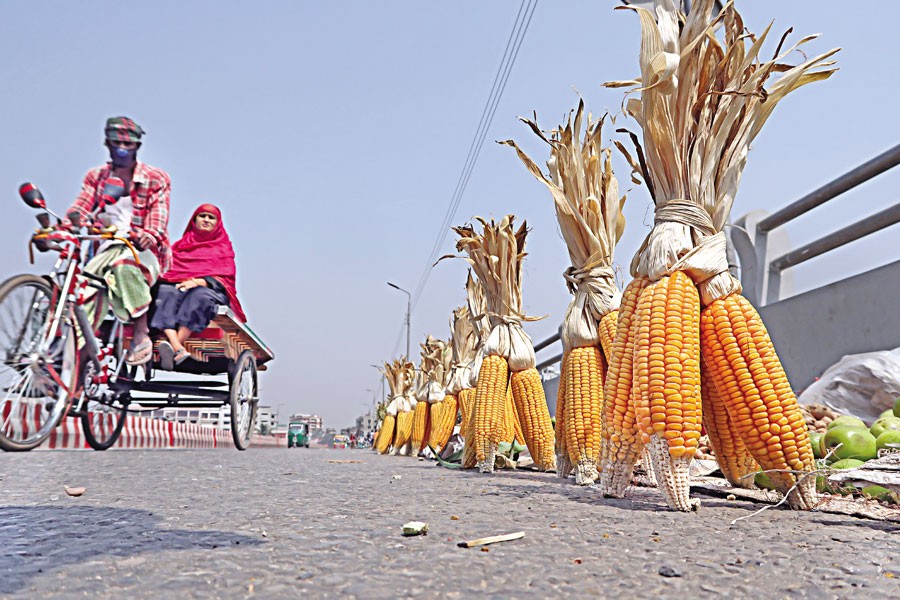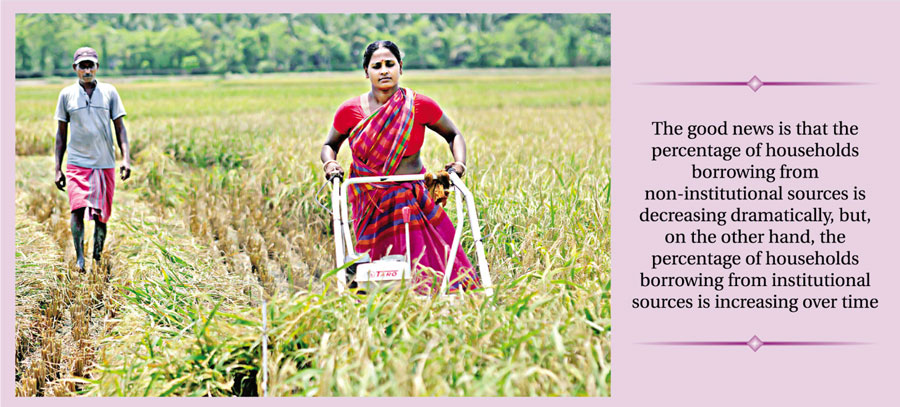 A rickshaw van moves past stacks of maize, which is the third major grain crop in Bangladesh — FE photo
A rickshaw van moves past stacks of maize, which is the third major grain crop in Bangladesh — FE photo 'When you have got a little,
it is often easy to get more.
The great difficulty is to get that little': Adam Smith (The Wealth of Nations)
 Over the last fifty years or so since Bangladesh's independence, the overall rural scenarios in the country have witnessed remarkable positive changes on many fronts -- self-sufficiency in food production to diversified agriculture to migration to mobile-phone penetration. Ipso facto, per-capita income rose and poverty declined over time. But, perhaps, changes in rural credit market would rank high given the multiplier and linkage effects of credit-led economic activities -- agricultural or non-agricultural.
Over the last fifty years or so since Bangladesh's independence, the overall rural scenarios in the country have witnessed remarkable positive changes on many fronts -- self-sufficiency in food production to diversified agriculture to migration to mobile-phone penetration. Ipso facto, per-capita income rose and poverty declined over time. But, perhaps, changes in rural credit market would rank high given the multiplier and linkage effects of credit-led economic activities -- agricultural or non-agricultural.
In fact, the news of rural transformation that roams around owes much to the transformation of rural markets where provisions of credit play pivotal roles. En passant, in economic jargon, markets are institutions that bring together the buyers and the sellers of inputs, outputs and services.
Think of Rabindranath Tagore's poem 'Dui bighajomi'. Poor Upen is being asked to sell his only endowment -- 60 decimals of land - to the landlord who has long been meeting Upen's credit needs. To repay the principal with exorbitant interest, Upen had gone down deep in debt. But gone are those days when non-institutional sources like landlord, mohajons, traders appeared as major actors on rural credit market, charging exorbitant rates of interest for the loaned out money. In today's Bangladesh, for example, poor people like Upen receive credits from formal sources like government, cooperatives and NGOs to transform inputs into outputs -- both agricultural and non-agricultural -and channelled through markets.
In fact, about 60 per cent of rural credits are now being supplied by NGOs, 10 per cent by banks and others and 30 per cent by non-institutional actors. Decades ago, the doors of rural markets were open for only Upen's 'Babus (lords)' to improve economic health; now they also access those doors.
In this article, we shall attempt to present the changing scenario of rural credit in Bangladesh drawing upon a panel data set covering 1988 and 2013/2014.
We can start the discussion with a background of the sources of rural credits, by land ownership group, in 1982 compiled jointly by BIDS and IFPRI. This is only the authentic information for early years of credit scenario in rural areas. In 1982, about two-thirds of rural households received credits from institutional sources and only 14 per cent accessed from institutional sources. More importantly, about 92 per cent of the functionally landless households borrowed from informal sources. As we shall see later, the ratio just reversed.

In this context, allow us to draw attention of readers to two developments. First, the incremental institutional contribution to credit came totally from NGOs, and not from banks, public or private, whose share has actually declined substantially over the years. Second, during the periods of comparison, the proportion of borrowers from informal or non-institutional markets declined. The steep fall can be adduced mainly to a sharp decline in loans from moneylenders, also supported by the decline in loans from landowner and trader subgroups. Thus, informal sources do not seem to hold the credit-key anymore in rural areas, due to the presence of a more cost-effective formal sources like NGOs. Third, the expansion of rural credit market is evidenced by the information that about 60 per cent of rural households accessed credit in recent years compared to about 40 per cent in the 1980s -- landless about 38 to 60, landowning 37 to 48 per cent. Fourth. About half of poor households borrowed from institutional sources compared to one-fifth in the1980s; from non-institutional sources the share declined to 30 per cent from 60 per cent.
SIZE OF LOANS: Over time, the average size of a loan increased from US$131 to about US$779. The average size of a loan from the banks increased even more substantially from US$136 to US$3001 -- over the period under comparison. That seems to reinforce our earlier hypothesis that banks have been serving lesser proportion of rural households and with more credits per household. Our field-level data also seemingly confirm that banks are more interested in quenching the thirst for credit of the rich than of the poor who lack credible collateral like land. However, quite opposite scenario prevails in the case of loans from NGOs. The average size of a loan from NGOs ranged between US$102 and about US$500, which indicates, perhaps, that NGOs cater to the needs of poor households whose absorptive capacity is relatively small. Remarkably, the size of loans from moneylenders increased from US$155 to US$550. Besides, a relatively softer and cost- effective option than moneylenders is borrowing from friends and relatives. They have also increased the average size of loans significantly over the comparable period. And, finally, the interest charged by money lenders averaged 50 per cent against 25 per cent by NGOs.
ACCESS TO CREDIT: Social scientists are interested in who takes loans and from whom. We observe that the proportion of total households (where households were classified based on land owned) receiving loans from banks increased. Although the proportion of medium and large households decreased over time in rural areas, they are still major loan recipients from banks in the recent periods, possibly implying that bank loans mostly went to the solvent segments in rural areas.
This supports our earlier suspicion that banks cater to the needs of large and medium farms in rural areas. It also appears that, irrespective of land ownership, all segments have increased their access to NGO credit. And in this case, the functionally landless households led with participation increasing nine times! The finding is not surprising given that NGOs target such households.
NOW COMING ROUND TO THE SECOND QUESTION: who gets the loan? In the base year 1988, one-fifth of the total institutional credits went to groups comprising functionally landless and marginal households (owning up to 0.2 ha). The medium and large groups got a little over one-third. But the situation changed dramatically over time with a reverse trend. Undoubtedly, and mostly on account of the NGOs, access to institutional sources by the poor segment has increased over the years, and it is good news for rural residents.
But a sad fix lies elsewhere and it is the "missing small". As we count, the share of the small households (owning 0.4 to 1.00 ha) accessing institutional credit almost halved during the period under comparison: from one-third to one-sixth. It is also clear that the landlords, who are medium and large farms, draw most of the institutional sources. Thus, seemingly, the small households have been gradually missing from the credit line. The sordid scenario could have arisen because NGOs consider them as too big to have access, while banks consider them as too small to have access with sufficient collateral.
Bear in mind that the "missing small" constitutes a third of farm households and control about one-fourth of the cultivated land in rural areas. Therefore, we can argue that the development of agriculture and rural livelihood system would remain a pipe dream until the small households are taken care of by the credit lines. That means, in course of time, they might swell the large army of landless households in Bangladesh.
The good news is that the percentage of households borrowing from non-institutional sources is decreasing dramatically, but, on the other hand, the percentage of households borrowing from institutional sources is increasing over time.
DO THE POOR PAY HIGHER INTEREST RATES? : Generally, we hear about two allegations in the context of the rural credit regime. First, the interest rates charged by the NGOs are relatively high and second, there exists an inverse relation between interest rate and land ownership. We observe that interest rates from all sources of loans came down from 53 percent in 1988 to average about 20 percent in 2014. The allegation that NGOs charge a relatively higher price for borrowed funds than other sources is not supported by our data. Special mention may be made of the complaint that NGOs have been behaving like moneylenders by charging exorbitant rates of interest. We observe that in both 1988 and 2014, the interest rates charged by moneylenders were much higher than that charged by NGOs. In fact, the interest charged by the NGOs has fallen over time. The second allegation centering around an inverse relation between land size and interest rate appears to be true in the earlier period but does not show a specific relation in the recent period.
Utilization of loans: We observe that the utilization of institutional credits for agricultural purposes has declined over time. For example, in the base year 1988, roughly 70 percent of the institutional loans went for meeting mostly agricultural needs for fixed and working capital. Of late, in the most recent times, that share is a little over one-third. On the other hand, the utilization of non-institutional loans tells a different story: loans for agricultural purposes increased almost 50 percent during this period. We presume that loans from institutional sources have been diverted to other expenses, and especially to non-agricultural pursuits.
For example, in the base year, roughly 10 percent of the total credits went to the non-agricultural sector; over time, it surged to almost half of the total lending. By and large, it appears that the lion's share of the loans from institutional and non-institutional sources is claimed by nonfarm activities, and institutional and non-institutional loans for consumption purposes have decreased over time.
That borrowing households have been allocating relatively more credit money to non-agricultural pursuits should not surprise us. There could be a range of factors for this, but we mention just a few. First, since the early 1980s, nonfarm activities have been growing at a rapid rate in rural areas. Household income data tend to show that the share of household income coming from nonagricultural sources has been rising. And, admittedly, this is a spillover or linkage effect of agricultural growth. Second, as we could learn, NGOs have been funding mostly nonagricultural activities. Thus, since most of the funds are now being made available by NGOs, especially to the poor, it is quite natural that borrower-households would allocate resources more to nonfarm activities.
INDEBTEDNESS OF CREDIT-DRIVEN HOUSEHOLDS: Does the NGO (MIFIs) credit contribute to deepening indebtedness in rural areas given that that borrowers have scant information about productive use of loans and the interest rate that it carries or do they resort to multiple borrowings to combat the crisis? The answer from sample households seem to say 'no' with only 15 per cent of rural households reporting either defaulting on current loans or or has accumulated debts due to failure of repayment (average size of debt in 2013 $652).
Interestingly, the major sources of overdue loans were from commercial banks and non-institutional sources of credit obtained from; only 1-3 per cent reported to be indebted to NGOs. And next, which households are so indebted than others? Disaggregated by landownership, education of household head and poverty status, the economically better-off households seem to be more indebted than households with less land and education -- e.g. only 12 per cent of the functionally landless vs, 24 per cent of the large land owners ; 11 per cent of illiterate vs. 21 per cent passing secondary level.
By and large, as in urban areas, the defaulters, willful or not, come from relatively wealthier segment of society. Maybe, the poor and educated ones cannot bypass the punishment of defaulting loans but the rich and educated ones can postpone punishment by any means. But the irony is that on the credit market, rural or urban, the bad borrowers drive good borrowers out of the market and bad borrowers dominate the credit market (in terms of amount, if not number).
In conclusion, a few pertinent points need to be stated as policy palliatives. First, it seems that cheap credit from parastatals (like banks in Bangladesh) could not drive out the actors in the informal sector (moneylenders, traders or landowners) from the credit market-- they still meet one-third of credit needs in rural areas. Nor can we hope that this will happen in future. In fact, the last 40 years of Indian experience increases our pessimism in this direction.
The pervasive presence of the informal market in the base year, along with cheap credits from banks, confirms this premise as applicable to Bangladesh. But it is also true that when banks failed on the heels of high screening costs and adverse selection, the NGOs stepped up to mitigate the credit constraint to some extent.
Finally, empirical evidence suggests that, as development proceeds and agricultural income level increases, the imperfections reflected in high interest rates on the rural capital market should be reduced. For example, as observed by researchers, in prosperous Bardawan in West Bengal, India, the interest rates range between 36 and 84 percent, while in relatively poorer Nadia, it is between 72 and 120 percent. Interest rates can be lowered indirectly through the provision of technological change and investment opportunities, and need not be lowered directly through subsidies to some borrowers on the formal credit market.
The major sources of overdue loans, as empirics show, were from commercial banks and non-institutional sources of credit obtained from; only 1-3 per cent reported to be indebted to NGOs. Which households are so indebted than others? Disaggregated by landownership, education of household head and poverty status, the economically better-off households seem to be more indebted than households with less land and education -- e.g. only 12 per cent of the functionally landless vs, 24 per cent of the large land owners ; 11 per cent of illiterate vs. 21 per cent passing secondary level.
Bangladesh rural credit market has thus become more inclusive, diversified but not by public or private banks but led by NGOs. The critics condemn government's involvement in extending agricultural credits to rural households as a history of frustration and wasteful endeavour -- sadly, a history of hype against hope. The existence of the informal market with money lenders, land owners and relatives is a sordid scenario but, maybe, that is due to inter-linked credit market -- altogether a different story.
But it must also be recognized that the role and incidence of inter-linked credit market in rural areas has drastically dwindled over time due to the presence of alternative sources of credit as mentioned before. This could be considered as another milestone in fifty years of rural credit in Bangladesh.
"A paddy husking mill is running at Bolpur. A mill of that kind, if brought here, could be very useful. This country is a country of paddy….. I wish, if farmers could share 5-10 taka each and run the machine collectively, it could usher in a spirit of working hand in hand. Loans from our Bank (Patisar Agricultural Bank) would easily help husking business here. Then, I was thinking of training the farmers on industry. Nothing grows here excepting paddy. They have only hard clay soil. I want to know whether pottery could be classified as a cottage industry. I mean, whether bringing small finance would help them carry out this activity together….Another training I would like to see is how to make umbrellas. If competent persons are available, this activity could expand in Silaidah region" - Rabindranath Tagore.
The author is a former Vice- chancellor and now teaching part-time at East West University. abdulbayes@ewubd.edu/abdulbayes@yahoo.com
© 2025 - All Rights with The Financial Express
